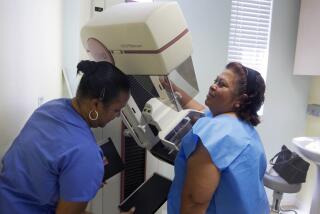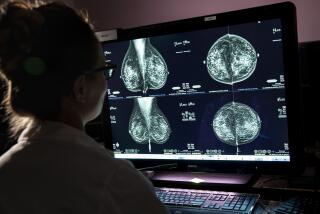MEDICINE / BREAST CANCER : Mammogram Benefits Questioned in Study
- Share via
Annual mammograms greatly improve early detection of breast cancer but apparently do not lessen the death rate from the disease, according to a Canadian study released Friday that was challenged by U.S. cancer officials.
The National Breast Screening Study, which tested almost 90,000 Canadian women ages 40 to 59, suggests that mammography offers no benefit over physical examination alone in reducing the number of deaths from breast cancer.
The study did say that the number of cancers detected with mammography was “substantially greater” than the number detected without it. “However, the real benefits of early detection remain to be demonstrated,” the study’s author, Dr. Anton Basinski, wrote in the Canadian Medical Assn. Journal to be published Sunday.
In the United States, officials at the National Cancer Institute and the Centers for Disease Control were quick to issue a response urging women to continue screening for breast cancer, beginning at age 40.
“Screening by mammography remains the single most effective method to detect breast cancer in its early, most curable stage,” officials said in a joint statement. It called for the results of the Canadian study to be analyzed further before any changes are made in guidelines for breast cancer screening.
Some cancer experts say the study period may have been too short to determine the long-term benefits of breast screening with X-rays.
“We’re concerned that women will throw out breast screening, and governments will throw it out, and really the study is not strong enough to support that sort of reaction,” said Dr. Elizabeth Kaegi, director of medical affairs for the Canadian Cancer Society.
“There still is evidence from other studies that early detection does make a difference,” Kaegi said in an interview.
The study, the largest to date in North America, began in 1980 and looked at two groups of women with no history of breast cancer: more than 50,000 ages 40 to 49 and almost 40,000 in the 50-59 age range.
Both age groups were randomly divided, with half of each group receiving annual mammograms plus physical breast examination and the remainder given physical exams only. All women were encouraged to perform monthly breast self-examinations.
In the younger group, more cases of breast cancer turned up among those who had mammograms--almost four cases per 1,000 women compared to 2.5 per 1,000 in those not given the X-rays.
Although more women from the mammogram group had died of cancer after seven years--38 compared to 28--researchers said the difference is not considered statistically significant.
“Our results confirm those from previously published reports on mammography screening alone: There is no evidence that screening for breast cancer is effective among women age 40 to 49 years, at least in the first seven years after initial screening,” the researchers said in their report.
For those women ages 50 to 59, the addition of mammography more than doubled the number of breast cancers detected compared to physical exam alone, “but it had no impact on the rate of death from breast cancer,” the study said.
“At seven years, the total number of deaths from breast cancer was virtually the same”--38 among women who had received regular mammograms and 39 among those who did not have the X-rays.






